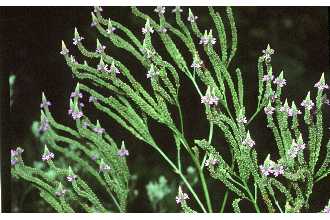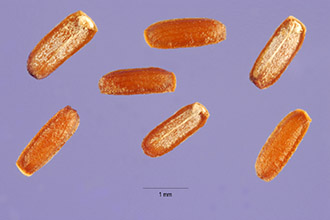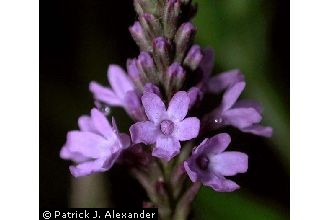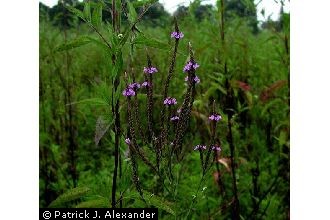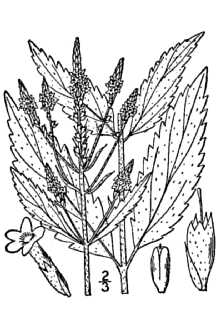Swamp Verbena
Scientific Name: Verbena hastata L.
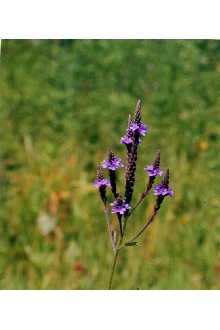
| General Information | |
|---|---|
| Usda Symbol | VEHA2 |
| Group | Dicot |
| Life Cycle | BiennialPerennial, |
| Growth Habits | Forb/herb |
| Native Locations | VEHA2 |
Plant Guide
Use a soil moisture meter to monitor the soil moisture where Swamp Verbena is planted.
Fact Sheet
Alternate Names
Swamp vervain Blue verbena Swamp verbena Simpler’s joy
Uses
Ethnobotanical: Blue vervain is used internally to treat depression, fevers, coughs, cramps, jaundice, and headaches. Externally, it is used for acne, ulcers, and cuts. Warning: Blue vervain can interfere with blood pressure medication and hormone therapy. Large doses will induce vomiting and diarrhea. Landscaping: Blue vervain produces very attractive purplish-blue flowers in late summer. It can grow in degraded wetland habitats and is an excellent landscaping substitute for several invasive species, including European wand loosestrife, purple loosestrife, and purple foxglove. Wildlife: The cardinal, swamp sparrow, field sparrow, song sparrow, and slate-colored junco eat the seeds of blue vervain. The cottontail rabbit will sometimes eat the foliage; most other mammalian herbivores avoid it due its bitter taste. The caterpillars of the verbena moth feed on the leaves and it is the larval host for the common buckeye butterfly. Long and short tongued bees collect the nectar and sometimes the pollen. Other bee pollinators include: epoline cuckoo bees, eucerine miner bees , halictid bees, and the verbena bee, a specialist pollinator. In addition the thread-waisted wasp, bee flies, thick-headed flies and golden soldier beetle are also known to all visit blue vervain.
Description and Adaptation
Adaptation
Adaptation
Blue vervain is a native, perennial wildflower that grows from 2 to 5 feet tall. Its hairy, square stems can be green or red. The toothed, lance shaped leaves progress in pairs up the stem and are about 6 inches long by 1 inch wide. Purplish-blue flowers bloom in multiple, showy, elongated panicles (flowers arranged on a stem) and are up to 5 inches long. Each bloom is about 1/4 inch across and conspicuously lobed. Blue vervain blooms in mid to late summer; approximately 1 1/2 months after blooming each bloom gives way to four oblong, reddish-brown, triangular-convex “nutlets.” Blue vervain spreads through rhizomes, horizontal roots that produce new plants. Blue vervain prefers moist conditions and full to partial sun. It can grow in disturbed sites and is commonly found in moist meadows, thickets, and pastures, as well as riversides, marshes, ditches, and river-bottom prairies. Blue Vervain distribution from USDA-NRCS PLANTS Database. For updated distribution, please consult the Plant Profile page for this species on the PLANTS Web site.
Establishment
General: Collect nutlets in late summer or early fall and spread them over a clean, dry, indoor surface for several days. Once the nutlets are dry, crush them lightly to release the ripe seeds. The seeds should be stratified before sowing by storing in a sealed, labeled container or plastic bag with wet sand or peat moss at 38 to 40 degrees Fahrenheit for three months. Propagation by seeds: After stratifying, sow seeds in a soil mix of one-third sand and two-thirds commercial plug mix. Keep the seeds well-lit and the air temperature between 60 and 80 degrees Fahrenheit. Established plants will self-seed in the fall. Propagation by cuttings: Take 3 to 4 inch long stem tip cuttings in early spring. Remove the lower leaves and insert the stems into a sand and perlite rooting medium. In 4 to 5 weeks the cuttings should be well rooted and can be transplanted. (For blue vervain, seed propagation is often preferred over propagation by cuttings.)
Management
Pinch off the tops of the plants several times during the growing season to encourage branching and a bushier growth habit.
Pests and Potential Problems
No known pests or potential problems.
Environmental Concerns
No known environmental concerns, Use soil moisture sensors to measure the soil moisture of Swamp Verbena.,
Control
Please contact your local agricultural extension specialist or county weed specialist to learn what works best in your area and how to use it safely. Always read label and safety instructions for each control method. Cultivars, Improved, and Selected Materials (and area of origin) There are no recommended cultivars or selected materials at this time. Prepared By: Samantha Kirk and Shawn Belt NRCS, Norman A. Berg National Plant Materials Center, Beltsville, MD

